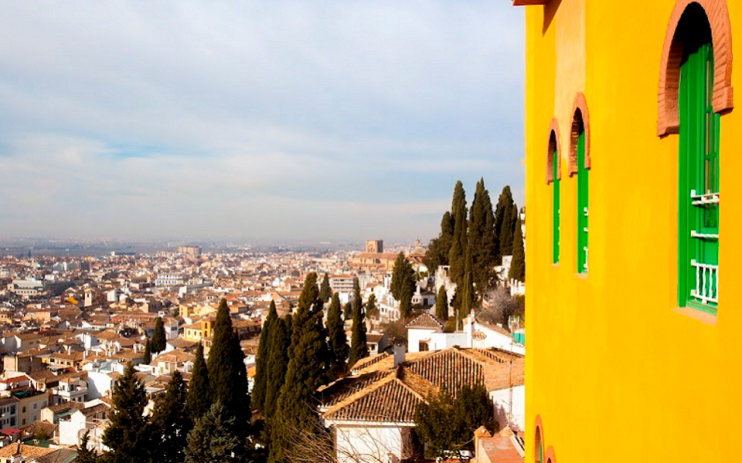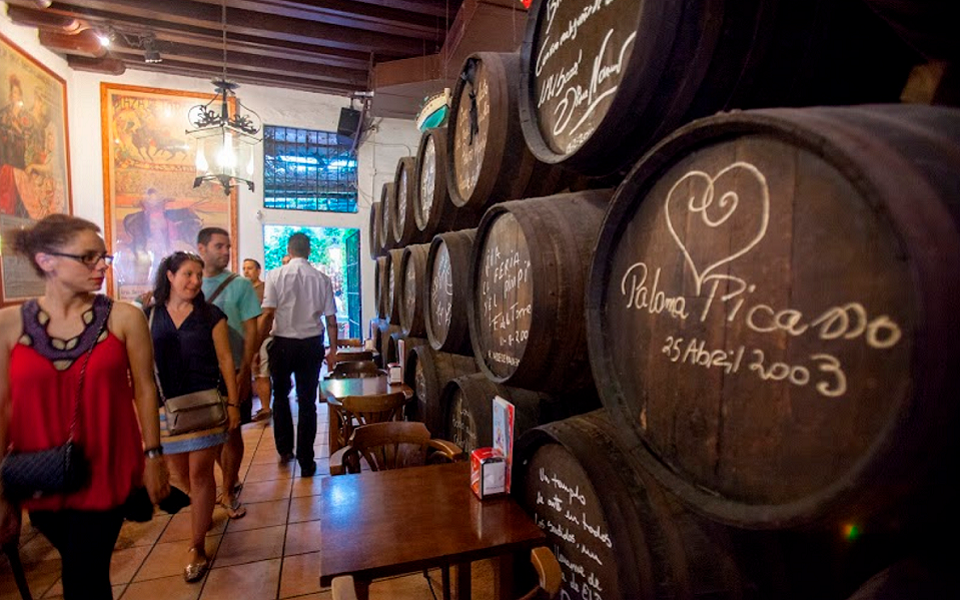A twin-city break in charming Andalucia is now easier than ever

“There should be more therapy involving fish,” says Carmen, my guide at the Riofrío caviar farm in the sleepy village of the same name, halfway between Granada and Malaga. Carmen’s crouching down and gazing into one of a dozen ten-metre-long pools of water. Behind her the backdrop of the angular Loja Mountains is framed by olive, eucalyptus, and willow trees.
I join Carmen at the water’s edge and tell her I agree with her proclamation. This is indeed a perfect setting for therapy. Other than one protective dog barking behind a nearby fence, the occasional swoosh of the tails of sturgeon fish are the only sounds. They’re swimming beneath me, the size of sharks, and some of the last remaining animals on Earth that hung out with the dinosaurs. For 200 million years, these cumbersome, genteel fish have produced eggs otherwise known as caviar.
Caviar sales have boomed in the last few years, although no one’s sure why – perhaps people who would’ve eaten the decadent fish eggs in restaurants ordered them for home during the lockdowns. Anyhow, Riofrío in Andalucia, which made the world’s first organic caviar in 2004, are buoyant about the future of caviar tourism.
Down the road in Malaga, Chef Diego Gallegos is at the forefront of modern caviar dining, if that were ever a thing. One of his dishes in Michelin-starred restaurant Sollo is caviar with oysters. “He prepares very strange novelties,” says Carmen approvingly. (I get a less approving gasp when I tell her I indulged in caviar on tomatoes the night before: “On a tomato!”) Riofrío has a small but perfectly formed collection of restaurants serving sturgeon fish, and the other local speciality of trout, and is an ideal stopover point between two of Andalucia’s beacons, Granada, an hour’s drive north, and Malaga, also an hour away on the south westerly coast.

A cork pops on the suntrap veranda of the new tasting room overlooking the sturgeon pools and we try traditional and Russian inspired caviar. Clearly not en vogue, the Russian style is problematically my favourite. It’s the richer and tastier of the two, but don’t worry, proceeds stay within the very Spanish Riofrío company. Overlooking the fish, which are, as Carmen puts it, “sacrificed” aged 18 for their eggs, this is a lovely lunch spot, and groups are invited to privately book. Food served includes the sturgeons themselves, as well as local organic asparagus and artichoke.
I was stopping en route to Malaga from Granada, as a road trip between the two cities is now more simply achieved by flying into one city’s airport and out of the other, thanks to an abundance of new Vueling flights into Granada.
On my first evening there I was eating with my guide Ivon at La Tana, the sort of eatery the tens of tavernas in this central part of the city had attempted to copy with varying levels of success. Alongside local cured pork, the region’s best, served soft as a boiled egg and dressed in a gentle oil, we had plentiful asparagus, and neat little white cubes of sturgeon fish.
Highly nutritional but low in fat, and smoked, it has a real depth of flavour. My local dining partner Trini tells me to enjoy it with “a little bit of salt, a little bit of pepper and just a drop of lovely oil” after I’d confessed my tomato-based horror story. (I stand by tomato and caviar offering salty-fresh joyousness just waiting for your approval.) The sturgeon is also brightened on the tongue with tangy local peppers.

Like in Olivander’s wand shop in Harry Potter, bottles of local wine are stuffed precariously in every wall crevice around La Tana, like they might fall at any second, hopefully onto our table. Granada is the only remaining city in Spain to serve complimentary tapas with drinks, and it’s a thrill to try this over three or four bars for dinner rather than sitting down at one restaurant in the traditional way. Here in the heart of town, diners spill out onto the streets in the same way drinkers do outside British pubs.
Organic food is a way of life in Andalucia: I’m told the fields outside of Granada are as replete with asparagus and artichoke as they ever have been; these vegetables often eschew meat as the most talked-about products from this part of Spain. While in town, don’t miss the Alhambra Palace, a labyrinthine piece of Islamic architecture. Visit by night for something special, without the hordes, and glance up at the particularly gorgeous original ceiling detail, some of which I thought looked like the imprints of a load of colourful ice cream cones being dropped onto a soft floor.
After noticing photos of myself in the local media – “UK journalists arrive to celebrate new flight route!” – I fled Granada for Malaga to eat at a new opening attempting to nudge forward conversations about organic cooking. The newly-opened Only You hotel’s rooftop restaurant near the harbour sources as many ingredients as possible from under one kilometre away. It’s subtle about its mission but bold in presenting flavours.

I ate vibrant local tomatoes mixed into a creamy but tart cheese from Malaga, a particular stand out which can be shared as an unusual starter. It felt like a provocative modern response to another local’s favourite, the steak tartare, but miraculously the tomatoes gave all the boisterous flavour of the real meaty thing. Will us Brits ever get over the flavour bursts of Mediterranean tomatoes? Then there was tuna tartare avocado with the kinds of flavours travelled seafood can’t reach.
A fifteen-minute amble otherwise known as an attempt to cure my slow food coma leaves me at El Pimpi for a wine chaser. It’s a lauded restaurant in Andalucia since the 1970s and Antonio Banderas has shares. Spain’s most famous export eschewed his Hollywood life to move back to Malaga, his home city, and while I eat local jamon I hear tales about how the Zorro actor lives stonethrow-close. He’s even scrawled his name onto a nearby sherry maturation barrel, as has Paulo Picasso, Picasso’s son, as the painter lived and worked here.
In the city centre, an inviting clash of winding streets and modern shopping thoroughfares interconnect, making Malaga walkable within an afternoon. Don’t miss the new, trendier Soho district, twenty minutes away on foot, where a cohort of vegan restaurants stand in proud opposition to the likes of the plate of Iberico jamon I ate in the nearby Mercado Central de Atarazanas.

There, I succumbed to a local gastronomic secret: take a fig, stuff an almond in the top of it, then eat it all in one for a salty-sweet chewfest you’ll try to recreate at home, but realise is impossible without local produce tasting this alarmingly good.
El Pimpi, I feel, sums up Andalucia. There’s an air of grandeur, but we still only pay a few euros for a beer, unlike in Spain’s capital city and Barcelona – making even the city’s finest dining establishments feel welcoming.
Across the table I was joined by a local who said simply: “Malaga is life.” A few glasses down, and with a wash of locals cascading past me en route to a quick lunch, it didn’t feel much like my life back home, but for a little while longer I was willing to suspend my belief.
How to do Andalucia yourself
Vueling flies to the Andalucian cities of Granada and Malaga from Gatwick. Eurostars Washington Irving in Granada and the Soho Boutique Equitativa in Malaga have doubles from £100 per night
